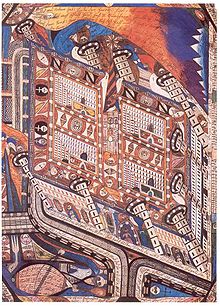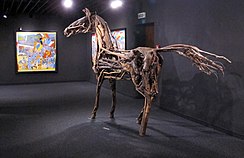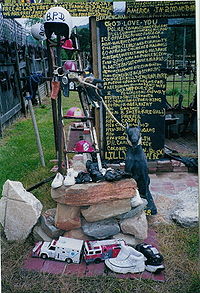
Jean Philippe Arthur Dubuffet was a French painter and sculptor of the Ecole de Paris. His idealistic approach to aesthetics embraced so-called "low art" and eschewed traditional standards of beauty in favor of what he believed to be a more authentic and humanistic approach to image-making. He is perhaps best known for founding the art movement art brut, and for the collection of works—Collection de l'art brut—that this movement spawned. Dubuffet enjoyed a prolific art career, both in France and in America, and was featured in many exhibitions throughout his lifetime.

Adolf Wölfli was a Swiss artist who was one of the first artists to be associated with the Art Brut or outsider art label.

The American Visionary Art Museum (AVAM) is an art museum located in Baltimore, Maryland's Federal Hill neighborhood at 800 Key Highway. The museum specializes in the preservation and display of outsider art. The city agreed to give the museum a piece of land on the south shore of the Inner Harbor under the condition that its organizers would clean up residual pollution from a copper paint factory and a whiskey warehouse that formerly occupied the site. It has been designated by Congress as America's national museum for visionary art.
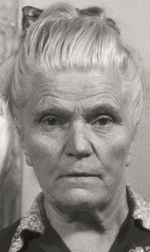
Aloïse Blanche Corbaz was a Swiss outsider artist included in Jean Dubuffet's initial collection of psychiatric art. She is one of very few acclaimed female outsider artists.

Judith Scott was an American fiber sculptor. She was deaf and had Down Syndrome. She was internationally renowned for her art. In 1987, Judith was enrolled at the Creative Growth Art Center in Oakland, California, which supports people with developmental disabilities. There, Judith discovered her passion and talent for abstract fiber art, and she was able to communicate in a new form. An account of Scott's life, Entwined: Sisters and Secrets in the Silent World of Artist Judith Scott, was written by her twin sister, Joyce Wallace Scott, and was published in 2016.

The Maria Gugging Psychiatric Clinic was a psychiatric institution located in the suburb of Maria Gugging on the outskirts of Vienna, Austria. During the Nazi era hundreds of mental patients were murdered or abused at Gugging as part of the Nazi Aktion T4 program.
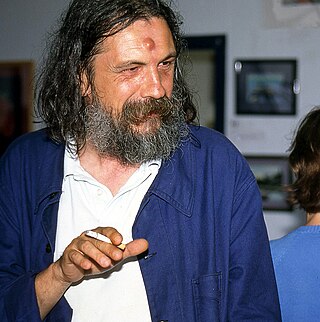
Jean Tirilly (1946–2009) was a French painter, born in 1946 in Léchiagat, Brittany, France. He painted in the Outsider Art tradition coined by the British art critic Roger Cardinal in 1974, first studied by the German psychiatrist and art historian Hans Prinzhorn in the 1920s, and popularized as Art Brut by the French abstract artist Jean Dubuffet in the 1950s. Tirilly's oeuvre stands among the strongest contemporary examples of Art Brut in Europe. His deft technique and unusual sense of vision and purpose, however, stand in sharp contrast to the commonly prescribed features of Art Brut, notably autodidacticism and dissociativism. As such, Tirilly is also a proponent of Marginal or Singular Art, an art current that eschews many of the habitual artistic qualifiers be they subject, style, method, or purpose. His work is included in the Neuve Invention section of the important Collection de l'art brut in Lausanne, Switzerland.

Pascal-Désir Maisonneuve was a French artist and mosaicist whose work is considered to be outsider art.

The Collection de l'art brut is a museum dedicated to outsider art located in Lausanne, Switzerland.
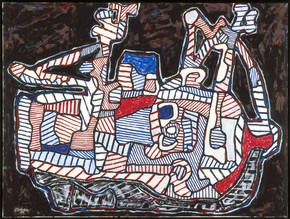
Courre Merlan (Whiting Chase) is an oil painting by French artist Jean Dubuffet. It has been part of the permanent collection of the Indianapolis Museum of Art since 1992.
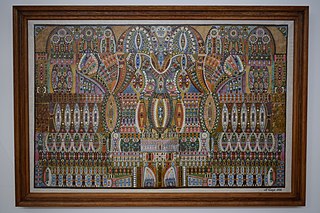
Augustin Lesage was a French coal miner who became a painter and artist through the help of what he considered to be spirit voices. His style utilizes patterns and symmetry on a large scale, often accompanied by bright, vibrant colors. He was untrained and is considered an outsider artist, part of Art Brut.

Vojislav Jakić was a Serbian painter, renowned as an outsider artist. His paintings and drawings display phantasmagoric visions of death, insects and human insides. His most significant works are exhibited in the Collection de l'art brut in Lausanne and Museum of Naive and Marginal Art in Jagodina.
Laure Pigeon (1882–1965) was a French medium who produced an oeuvre of 500 drawings related to her Spiritualist practice. She is considered one of the foremost Art Brut creators.
Jeanne Tripier (1869–1944) was a French medium who produced works of text, drawing and embroidery under Spiritualist influence. She is considered part of the Art Brut canon.

Lucienne Peiry, born in Lausanne on 4 September 1961, holds a doctorate (PhD) in the history of art; she is a specialist in Outsider Art, an exhibition curator, a lecturer and the author of several publications. She gives lectures in both Switzerland and elsewhere in Europe, and has been teaching Outsider Art at the Swiss Federal Institute of Technology in Lausanne since 2010. Since 2016, she has also been teaching at the University of Lausanne
Magali Herrera (1914–1992) was a Uruguayan self taught artist who wrote, danced, acted and made films in addition to producing the oeuvre of paintings of Utopias, for which she is known.

Paul Christopher Lamantia is an American visual artist, known for paintings and drawings that explore dark psychosexual imagery. He studied at the School of the Art Institute of Chicago and emerged in the 1960s and 1970s as part of the larger group of artists known as the Chicago Imagists.
Juliette Élisa Bataille was a French textile and outsider artist. She created small embroideries with the character of paintings, by sewing silk, cotton, and wool onto rectangular pieces of cardboard. She is known for the works she composed during a three-year period at Ville-Évrard Psychiatric Hospital. She met the artist Jean Dubuffet at the hospital, who was collecting art brut.
Madeleine Lommel (1923-2009) was a French outsider artist and founder of the first outsider artist museum in Paris, l'Aracine which became the Musée d'Art Brut. She was a prominent supporter of outsider art in France.
